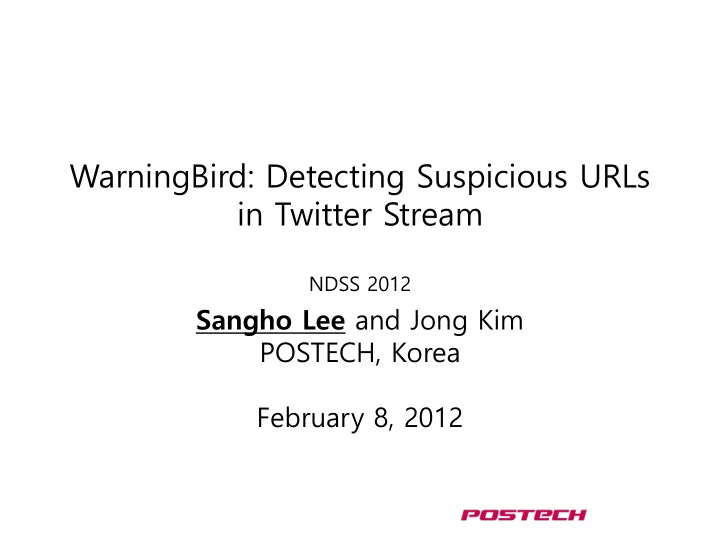

WarningBird: Detecting Suspicious URLs in Twitter Stream NDSS 2012 Sangho Lee and Jong Kim POSTECH, Korea February 8, 2012
Suspicious URLs in Twitter • Twitter suffers from malicious tweets. – Containing URLs for spam, phishing, … • Many detection schemes rely on – Features of Twitter accounts and msgs. – Features of URL and content • Many evading techniques also exist. – Feature fabrication – Conditional redirection NDSS 2012 2
Conditional Redirection • Attackers distribute initial URLs of conditional redirect chains via tweets. • Conditional redirection servers will lead – Normal browsers to malicious landing pages – Crawlers to benign landing pages • User agent, IP addresses, repeated visiting, … Misclassifications can occur NDSS 2012 3
Motivation and Goal • Attackers can evade previous detection schemes. – Selectively provide malicious content to normal browsers not to investigators • We propose a novel suspicious URL detection system for Twitter. – Be robust against evasion techniques – Detects suspicious URLs in real time NDSS 2012 4
Outline • Introduction • Case Study • Proposed Scheme • Evaluation • Discussion and Conclusion NDSS 2012 5
Case Study blackraybansunglasses.com 6584 different accounts & short URLs (3% of daily sample) google.com for reused crawlers random spam page for normal browsers NDSS 2012 6
Outline • Introduction • Case Study • Proposed Scheme – Basic Idea – System Overview – Derived Features • Evaluation • Discussion and Conclusion NDSS 2012 7
Basic Idea • Attackers need to reuse redirection servers. – No infinite redirection servers • We analyze a group of correlated URL chains. – To detect redirection servers reused – To derive features of the correlated URL chains NDSS 2012 8
System Overview • Data collection – Collect tweets with URLs from public timeline – Visit each URL to obtain URL chains and IP addresses • Feature extraction – Group domains with the same IP addresses – Find entry point URLs – Generate feature vectors for each entry point NDSS 2012 9
System Overview (continued) • Training – Label feature vectors using account status info. • suspended Þ malicious, active Þ benign – Build classification models • Classification – Classify suspicious URLs NDSS 2012 10
Features • Correlated URL chains – Length of URL redirect chain – Frequency of entry point URL – # of different initial and landing URLs • Tweet context information – # of different Twitter sources – Standard deviation of account creation dates – Standard deviation of friends-followers ratios NDSS 2012 11
Outline • Introduction • Case Study • Proposed Scheme • Evaluation – System Setup and Data Collection – Training Classifiers – Data Analysis – Detection Efficiency – Running Time • Discussion and Conclusion NDSS 2012 12
System Setup and Data Collection • System specification – Two Intel Quad Core Xeon 2.4 GHz CPUs – 24 GiB main memory • Data collection – Twitter Streaming API – One percent samples from Twitter public timeline (Spritzer role) – 27,895,714 tweets with URLs between April 8 and August 8, 2011 (122 days) NDSS 2012 13
Training Classifiers • Training dataset – Tweets between May 10 and July 8 – 183,113 benign and 41,721 malicious entry point URLs • Classification algorithm – L2-regularized logistic regression • 10-fold cross validation – FP: 1.64%, FN: 10.69% NDSS 2012 14
Data Analysis 3758 entry point URLs (on average, daily) 283 suspicious URLs 20 false positive URLs 30 new suspicious URLs • Relatively small number of new suspicious URLs – We detect suspicious URLs that are not detected or blocked by Twitter. NDSS 2012 15
Data Analysis (continued) • Reoccurrences of May 10’s URLs • Up to 12% benign & 52% suspicious URLs NDSS 2012 16
Detection Efficiency • We measure the time difference between – When WarningBird detects suspicious accounts – When Twitter suspends the accounts Avg. time difference: 13.5 min more than 20 hours NDSS 2012 17
Running Time • Processing time for each URL: 28.31 ms – Redirect chain crawling: 24.20 ms • Hundred crawling threads – Domain grouping: 2.00 ms – Feature extraction: 1.62 ms – Classification: 0.48 ms • Our system can classify about 127,000 URLs per hour. – About 12.7% of all public tweets with URLs per hour NDSS 2012 18
Outline • Introduction • Case Study • Proposed Scheme • Evaluation • Discussion and Conclusion NDSS 2012 19
Discussion • Evasion is possible but restricted. – Do not reuse redirection servers • Need extra $ (to buy compromised hosts) • Need more effort to take down hosts – Reduce the rate of malicious tweets • Less effective NDSS 2012 20
Conclusion • We proposed a new suspicious URL detection system for Twitter. • Our system is robust against feature fabrication and conditional redirection. • Evaluation results show accuracy and efficiency. NDSS 2012 21
Recommend
More recommend